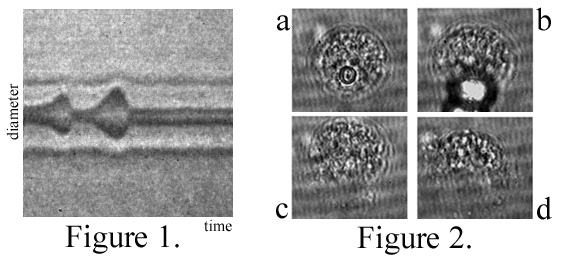Using Sound to Locate White Blood Cells
and Deliver Therapy
and Deliver Therapy
Paul A. Dayton, pad4v@unix.mail.virginia.edu
Jonathan Lindner, Jim Chomas, Scott Simon, Matthw Coggins, Kathy Ferrara
Division of Biomedical Engineering, University of California at Davis
Davis, CA 95616
Division of Cardiology, University of Virginia
Charlottesville, VA 22903
Popular version of paper 3aBB4
Presented Wednesday morning, Nov. 3, 1999
138th ASA Meeting, Columbus, Ohio
White blood cells are the army of the human immune system. Although they make up only about 1 percent of blood, they are the primary mechanism for defending the body against invading bacteria, viruses, fungi, and parasites. In the event of injury or infection, the immune system reacts with a response known as inflammation. During inflammation, certain types of white cells (called neutrophils) become activated and adhere to the walls of the blood vessels of the effected area. Neutrophils can then migrate from the vessel wall into the tissue where they are attracted to sites of extravascular injury or infection. These neutrophils, also known as phagocytes, along with other types of white cells, neutralize matter which is foreign to the body by a process known as phagocytosis. Phagocytosis, which literally means "cell-eating," is the process by which a cell engulfs a foreign particle. Ultrasound contrast agents are microscopic bubbles which are used to enhance the visibility of blood during an ultrasound study. The average size of these bubbles is typically 1-3 microns in diameter (a micron is a millionth of a meter; white blood cells are around 10-20 microns), and hence the bubbles are small enough so that they can traverse the smallest blood vessels. Because of their acoustic properties, these microbubbles are far more echogenic than blood, which makes it possible to detect a single bubble with an ultrasound scanner. Our results indicate bubbles retain their extreme echogenicity after they have been phagocytosed by neutrophils. At the site of infection or injury, where neutrophils are programmed to concentrate, their presence can be detected during an ultrasound exam. To do this, a solution of microbubbles would be injected into the bloodstream. Neutrophils which have become activated due to injury or infection will phagocytose these foreign particles. The neutrophils are then labeled with a microbubble "marker" which can be detected. This strategy has been successful in detecting inflammation in animal models. Another potential use of microubbles is as a therapeutic delivery system. With certain combinations of acoustic parameters, it has been observed that these bubbles and even their host cells can be ruptured. Drugs can be placed on the bubbles or within the neutrophil, and can then be acoustically released at the desired site (where they are concentrated by neutrophils) to provide treatment directly to the site of inflammation or infection. In summary, the ability to detect and disrupt microbubbles within neutrophils provides a novel approach for detecting activated cells at an inflammatory site and provides the possibility to deliver therapy directly using acoustic energy.

Figure 1 shows a diameter-time curve of a phagocytosed microbubble resonating as it experiences a moderate-intensity (500 kPa) acoustic pulse. The nearly horizontal lines parallel to the bubble trace are produced by the cell wall. This significant expansion and contraction of the microbubble produces a detectable acoustic signal.
Figure 2 shows four frames of a neutrophil with a phagocytosed microbuble before insonation (a), during insonation at the time of maximum buble expansion (b), and after insonation (c,d) with a high-intensity acoustic pulse (1.6 MPa). Frames (c,d) show that the expansion of the bubble has ruptured the cell wall, allowing the cytoplasm to disperse into the surrounding fluid.